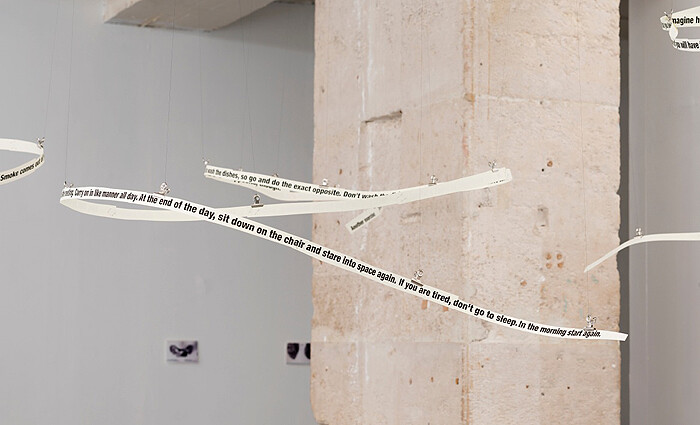10 Anarcho-communist minutes (all works, 2013) consists of a long list of general questions about collectivity—though it could be a rhetorical monologue or an address to an imaginary spectator. They are written on yellowish pages torn from a book dedicated to foundry work and sand molding. These pages are suspended in a curved line in the gallery space. When walking slowly around this text-sculpture and reading earnest questions—“Can everyone work?” and “What do you desire?”—one cannot ignore the fatigued images of metallurgists, furnaces, other complex machinery, and some (rather scary) chemical formulae on the pages. At a certain stage one begins to wonder: what is the heavy machine industry doing in a show on hysteria?
An answer lies in Zbyněk Baladrán’s other sculptural texts. In fact, in order to read them the spectator-cum-reader has to twist and turn his neck, bend down, or go up on tippy toes, and, in some extreme cases, lie down on the floor to locate some particularly inaccessible parts. Driven by the thoroughness of a trained art historian, I seriously intended to do so, but was intercepted by the gallerist, who politely indicated the presence of the exhibition brochure. There weren’t many viewers in the space when I was there, but no stretch of the imagination was required to picture it full of bending, stretching, and supine spectators nolens volens turned into dancers (of the modernist sort).
After all the efforts of performative reading, I moved to the double LCD screen placed on the floor, displaying Preliminary Report. Of the several suggested movement options (sit, stand, bend?), I chose the easiest. Plopping down directly on the floor I watched Baladrán’s video, which provides us with an undone puzzle of fragmented clues. Images do not “illustrate” the text by any means, but rather are intertwined in diverse ways, creating new connections and non-evident links. To some extent, the exhibition can be compared to a screenplay, like the quasi-tautology once described by Pasolini as “the screenplay as a structure that wants to be another structure.” Neither textual work, nor a literary genre, the exhibition’s texts test out different forms of performative conceptualism. By making the spectator into an accomplice, Baladrán places his floating “scenarios” in the exhibition space, transforming it into a reflective play on work, hysteria, new horizons, and the questions of so-called anarchist collectivities applied to today’s concerns.
Preliminary Report, for example, is loosely based on the Studien über Hysterie (1895) by Sigmund Freud and (his mentor) Josef Breuer. The two-channel film is compiled of found footage of “experimental work” in which miners are very present, and a case study of a “forty year-old woman of youthful appearance,” displaying some so-called hysterical symptoms. Her “frightening memories” are elaborated upon, her nightmares described, and several “objective” observations added, such as: “She often answers questions in a convoluted way, so people do not understand her.”
The history of medicine is marked by the rise and decline of diseases that appeared to have increased dramatically in particular times and cultural settings. Alongside melancholia in the seventeenth century, or neurasthenia in the late nineteenth, hysteria’s heyday met its metaphorical finishing line in the latter part of the twentieth century. Known as “somatization disorder” today, hysteria lost its legendary aura, dwindling largely due to its reduced occurrence, and then disappearing altogether from serious diagnostics. Baladrán uses it as such—a scientific myth, a fictionalized disease, narrated throughout the exhibition in diverse ways and serving as a screen for his reflections on subjectivity, emancipation of the senses, and methodology of work.
His examples of “work” throughout the exhibition are quite emblematic—they come from the heavy industry of “socialist” times, in which Fordist ideas rationalized menial tasks, repeated ad infinitum. Baladrán juxtaposes mining or metallurgy—as an extremely labor-intensive, energy-consuming, and highly organized mode of production—to the psychological mystery of organization. What would be the very basics, the axioms of productive organization? What if we were to emancipate the senses in lieu of a hysterical identification with a machine? The enthusiastic mechanics of communism were eloquently described in Dziga Vertov’s “Manifesto on the Disarmament of the Theatrical Cinematography” (1922), which Baladrán cites as one of his inspirations. Originally trained as a musician and neurologist, Vertov obsessively celebrated a certain sensual mode of production: “In revealing the machine’s soul, in causing the worker to love his workbench, the peasant his tractor, the engineer his engine, we introduce creative joy into all mechanical labor….”
Different obsessions, syndromes, symptoms, and disorders are suggested in Baladrán’s work throughout the exhibition—be it instructions of refusal (Three Exercises), or a fearful monologue on the (im)possibilities of co-existence (as in the aforementioned 10 Anarcho-communist minutes). It seems, though, that the disavowal of the neat ordering of phenomena is a principal theme of the exhibition itself. All these proposals have a slight parodic twist and betray an epistemological skepticism that undermines facile attempts at interpretation—of hysterical women, or of ecstatic communist labor.






